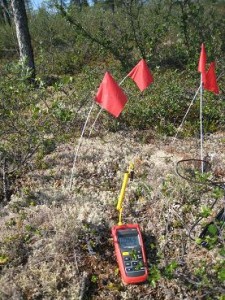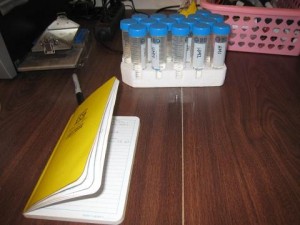Boreal forest surrounds the globe at northern latitudes. In Eastern Siberia the boreal forest is composed primarily of mosses, lichens, grasses, shrubs and larch trees. These vegetation types are found in different locations across the landscape, often with only one vegetation type in one location. As the climate changes, the locations and quantity of different vegetation types will change. I am interested in how differences in vegetation type might correspond to differences in soil characteristics surrounding each vegetation type, a topic that has not been well studied in the arctic and has implications for climate change. If there are differences in soil characteristics, there should also be differences in the bacteria and fungi living there, as well. This is important in the release of greenhouse gases, because bacteria and fungi eat carbon in the soil and release carbon dioxide and methane. Through my research, I would like to determine the relationship between vegetation type, soil, and bacteria and fungi, and how this relationship affects the release of greenhouse gases. Therefore, I am trying to characterize the environment surrounding four different vegetation types: moss, lichen, birch shrubs, and alder shrubs.

I am taking measurements of various soil characteristics and observing bacterial and fungal communities in each vegetation type. Life in the arctic is limited by the annual thaw cycle. In the winter the ground is entirely frozen and throughout the summer the soil begins to thaw from the top down, allowing life near the surface. Because of its impact on the ability of life to survive, I am taking measurements of changes in thaw depth over time and soil temperature and soil moisture, which both affect thaw depth. Bacteria and fungi eat compounds made of carbon and nitrogen, some of which are more easily digestible than others, so I am also measuring carbon and nitrogen content to determine both the amount and the accessibility of these food sources in the soil. In the lab, I am using a new technique to observe the bacteria and fungi from the different vegetation types by feeding them different carbon compounds. This allows us to determine how the bacteria and fungi differ based on what they eat. This research will give us a picture of what changes we can expect to see in the arctic environment in the future and the implications these changes have on the release of greenhouse gases.





Comment(1)-
Anita Hunt says
July 23, 2013 at 9:51 pmBackyard gardeners know that the soil for different crops must be amended to support those crops, i.e. tomatoes and pumpkins won’t necessarily grow in the same soil and nothing wants to grow where corn has been planted the year before.
In Sergy Zimov’s essay (Pleistocene Park: Return of the Mammoth’s Ecosystem), he suggests that the moist soils prevent adequate decomposition of plants that would return needed nutrients to the top soils that sustain new growth. It will be interesting to read about what you have found that keeps the vegetation sustained, particularly the shrubs which don’t usually root to shallow in the soil.